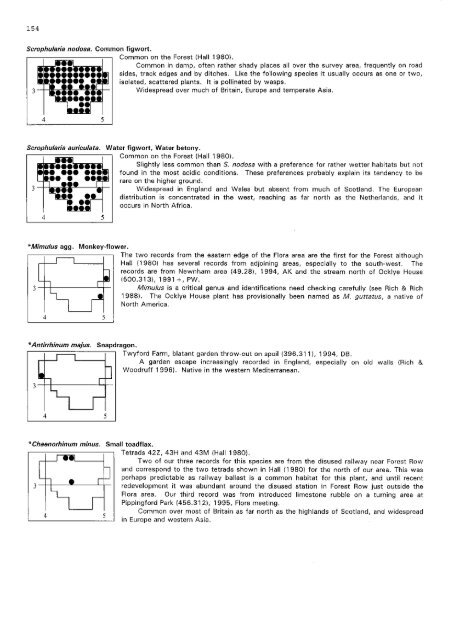Flora of Ashdown Forest - Botanical Society of the British Isles
Flora of Ashdown Forest - Botanical Society of the British Isles
Flora of Ashdown Forest - Botanical Society of the British Isles
Create successful ePaper yourself
Turn your PDF publications into a flip-book with our unique Google optimized e-Paper software.
154Scrophularia nodosa. Common figwort.Common on <strong>the</strong> <strong>Forest</strong> IHall 1980).Common in damp, <strong>of</strong>ten ra<strong>the</strong>r shady places all over <strong>the</strong> survey area, frequently on roadsides, track edges and by ditches. Like <strong>the</strong> following species it usually occurs as one or two,isolated, scattered plants. It is pollinated by wasps.Widespread over much <strong>of</strong> Britain, Europe and temperate Asia.Scrophularia auriculata. Water figwort, Water betony.Common on <strong>the</strong> <strong>Forest</strong> IHall 1980).Slightly less common than S. nodosa with a preference for ra<strong>the</strong>r wetter habitats but notfound in <strong>the</strong> most acidic conditions. These preferences probably explain its tendency to berare on <strong>the</strong> higher ground.Widespread in England and Wales but absent from much <strong>of</strong> Scotland. The Europeandistribution is concentrated in <strong>the</strong> west, reaching as far north as <strong>the</strong> Ne<strong>the</strong>rlands, and itoccurs in North Africa.*Mimulus agg. Monkey~flower.The two records from <strong>the</strong> eastern edge <strong>of</strong> <strong>the</strong> <strong>Flora</strong> area are <strong>the</strong> first for <strong>the</strong> <strong>Forest</strong> althoughHall (1980) has several records from adjoining areas, especially to <strong>the</strong> south-west. Therecords are from Newnham area (49.28), 1994, AK and <strong>the</strong> stream north <strong>of</strong> Ocklye House1500.313),1991 +, PW.3 Mimulus is a critical genus and identifications need checking carefully (see Rich & Rich1988). The Ocklye House plant has provisionally been named as M. guttatus, a native <strong>of</strong>North America.4 5*Antirrhinum majus. Snapdragon.Twyford Farm, blatant garden throw-out on spoil 1396.311 ), 1994, DB.A garden escape increasingly recorded in England, especially on old walls (Rich &Woodruff 1996). Native in <strong>the</strong> western Mediterranean.3-+~--------~-4 5*Chaenorhinum minus. Small toadflax.Tetrads 42Z, 43H and 43M IHall 1980).Two <strong>of</strong> our three records for this species are from <strong>the</strong> disused railway near <strong>Forest</strong> Rowand correspond to <strong>the</strong> two tetrads shown in Hall (1980) for <strong>the</strong> north <strong>of</strong> our area. This wasperhaps predictable as railway ballast is a common habitat for this plant, and until recent3 --++-__'!Il...-__---1....!--redevelopment it was abundant around <strong>the</strong> disused station in <strong>Forest</strong> Row just outside <strong>the</strong><strong>Flora</strong> area. Our third record was from introduced limestone rubble on a turning area at4 5Pippingford Park 1456.312), 1995, <strong>Flora</strong> meeting.Common over most <strong>of</strong> Britain as far north as <strong>the</strong> highlands <strong>of</strong> Scotland, and widespreadin Europe and western Asia.
















